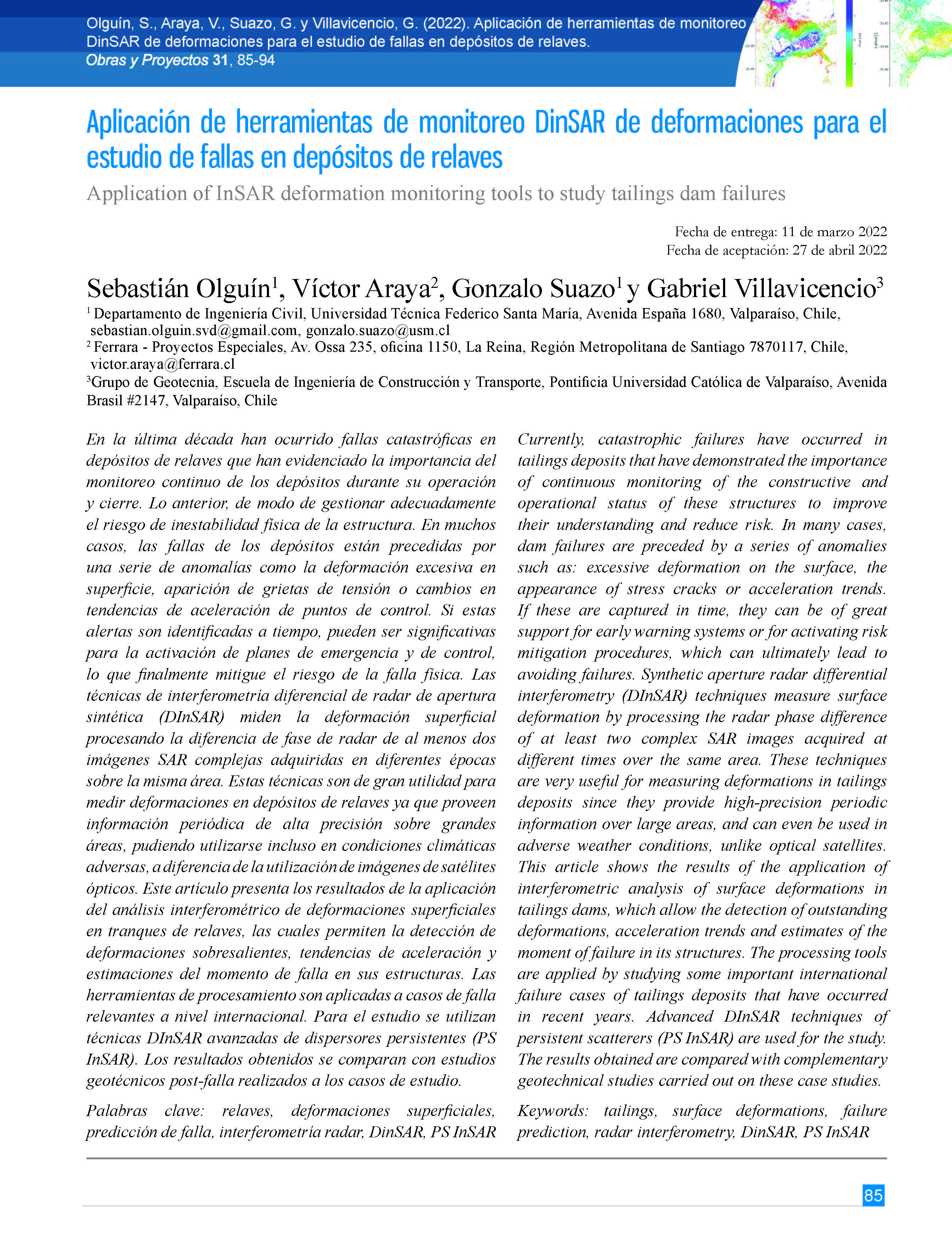Application of InSAR deformation monitoring tools to study tailings dam failures
DOI:
https://doi.org/10.4067/S0718-28132022000100085Keywords:
tailings, surface deformations, radar interferometry, DinSAR, PS InSARAbstract
Currently, catastrophic failures have occurred in tailings deposits that have demonstrated the importance of continuous monitoring of the constructive and operational status of these structures to improve their understanding and reduce risk. In many cases, dam failures are preceded by a series of anomalies such as: excessive deformation on the surface, the appearance of stress cracks or acceleration trends. If these are captured in time, they can be of great support for early warning systems or for activating risk mitigation procedures, which can ultimately lead to avoiding failures. Synthetic aperture radar differential interferometry (DInSAR) techniques measure surface deformation by processing the radar phase difference of at least two complex SAR images acquired at different times over the same area. These techniques are very useful for measuring deformations in tailings deposits since they provide high-precision periodic information over large areas, and can even be used in adverse weather conditions, unlike optical satellites. This article shows the results of the application of interferometric analysis of surface deformations in tailings dams, which allow the detection of outstanding deformations, acceleration trends and estimates of the moment of failure in its structures. The processing tools are applied by studying some important international failure cases of tailings deposits that have occurred in recent years. Advanced DInSAR techniques of persistent scatterers (PS InSAR) are used for the study. The results obtained are compared with complementary geotechnical studies carried out on these case studies.
References
Bowker, L.N. and Chambers, D. (2015). The risk, public liability and economics of tailings storage facility failures. http://www.csp2.org/files/reports/Bowker
Carlà, T., Intrieri, E., Di Traglia, F., Nolesini, T. Gigli, G. and Casagli, N. (2017). Guidelines on the use of inverse velocity method as a tool for setting alarm thresholds and forecasting landslides and structure collapses. Landslides 14 (2), 517-534. https://doi.org/10.1007/s10346-016-0731-5
Crosetto, M., Crippa, B., Biescas, E., Monserrat, O. and Agudo, M. (2005). State-of-the-art of land deformation monitoring using differential SAR Interferometry. ISPRS Workshop 2005: High-Resolution Earth Imaging for Geospatial Information . Hannover, Germany.
Dick, G.J., Eberhardt, E., Cabrejo-Liévano, A.G., Stead, D. and Rose, N.D. (2014). Development of an early-warning time-of-failure analysis methodology for open-pit mine slopes utilizing ground-based slope stability radar monitoring data. Canadian Geotechnical Journal 52 (4), 515-529. https://doi.org/10.1139/cgj-2014-0028
Ferretti, A., Prati, C. and Rocca, F. (2001). Permanent scatterers in SAR Interferometry. IEEE Transactions on Geoscience and Remote Sensing 39 (1), 8-20. https://doi.org/10.1109/36.898661
Fukuzono, T. (1985). A new method for predicting the failure time of a slope. 4thInternational Conference and Field Workshop on Landslides , Tokyo, Japan, 145-150.
Hooper, A., Zebker, H., Segall, P. and Kampes, B. (2004). A new method for measuring deformation on Volcanoes and other natural terrains using InSAR Persistent Scatterers. Geophyiscal Research Letters 31 , 1-5. https://doi.org/10.1029/2004GL021737
Morgenstern, N., Jefferies, M., Van Zyl, D. and Wates, J. (2019). Report on NTSF Embankment Failure. Ashurst Australia, Independent Technical Review Board.
Morgenstern, N., Vick, S., Viotti, C. and Watts, B. (2016). Report on the immediate causes of the failure of the Fundão Dam. Cleary Gottlieb Steen & Hamilton LLP, Fundão Tailings Dam Review Panel.
Mudd, G. (2007). Global trends in gold mining: Towards quantifying environmental and resource sustainability? Resources Policy 32 (1-2), 42-56. https://doi.org/10.1016/j.resourpol.2007.05.002
Petley, D.N., Bulmer, M.H. and Murphy, W. (2002). Patterns of movement in rotational and translational landslides. Geology 30 (8), 719-722. https://doi.org/10.1130/0091-7613(2002)030%3C0719:POMIRA%3E2.0.CO;2
Robertson, P., de Melo, L., Williams, D. and Wilson, W. (2019). Report of the expert panel on the technical causes of the failure of Feijão Dam I. Vale, Expert Panel.
Roche, C., Thygesen, K. and Baker, E. (2017). Mine tailings storage: Safety is no accident. A UNEP Rapid Response Assessment. Nairobi and Arendal: United Nations Environment Programme and GRID-Arendal.
Sánchez, C., Del Conte, S. and Verdugo, M.Á. (2019). Operational InSAR monitoring for tailings dams. Tailings 2019:6thInternational Seminar on Tailings Management . Santiago, Chile.
Vanden Berghe, J.-F., Ballard, J.-C., Wintgens, J.-F. and List, B. (2011). Geotechnical risks related to tailings dam operations. Tailings and Mine Waste Conference . University of British Columbia Library, Vancouver, Canada. https://doi.org/10.14288/1.0107739
Voight, B. (1989). A relation to describe rate-dependent material failure. Science 243 , 200-203. https://doi.org/10.1126/science.243.4888.200

Downloads
Published
Issue
Section
License

This work is licensed under a Creative Commons Attribution-NonCommercial 4.0 International License.







